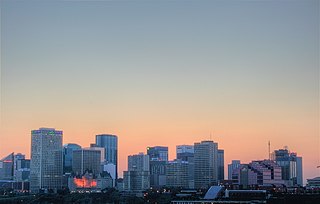Bonnie Doon is a neighbourhood in south-central Edmonton, Alberta, Canada. The well-known Mill Creek Ravine Park forms its west boundary. The Bonnie Doon shopping mall is on its east boundary.

Cloverdale is a river valley neighbourhood in Edmonton, Alberta, Canada located on the south side of the North Saskatchewan River. It is located immediately across the river from the downtown core and the river valley neighbourhood of Riverdale. Southside neighbourhoods overlooking Cloverdale include: Bonnie Doon, Strathearn, Holyrood, and Forest Heights. The southwest corner of the neighbourhood is bounded by Connor's Road, the approaches to the Low Level Bridge, and the mouth of the Mill Creek Ravine. The Low Level Bridge and James McDonald Bridge connect the neighbourhood to the north side, while Scona Road provides access to Old Strathcona.

West Jasper Place is a residential neighbourhood in west Edmonton, Alberta, Canada. Originally part of the Town of Jasper Place, West Jasper Place became a part of Edmonton when Edmonton and Jasper Place amalgamated on August 17, 1964.

Strathearn is a roughly triangular shaped residential neighbourhood in south central Edmonton, Alberta, Canada. Most of the development in Strathearn dates to the 1940s and 1950s.
Avonmore is a residential neighbourhood in south east Edmonton, Alberta, Canada. It was named after Algernon William Yelverton, 6th Viscount Avonmore, a priest from Ireland. It is in the shape of an irregular quadrilateral bounded on the south east by Argyll Road, on the south west by Mill Creek Ravine, on the north by 76 Avenue and on the east by 75 Street. It is surrounded by a mixture of residential neighbourhoods and industrial subdivisions. To the north is the residential subdivision of King Edward Park. To the east and south east are the industrial subdivisions of Girard Industrial and Coronet Addition Industrial. Separated from Avonmore by the Mill Creek Ravine are the residential neighbourhoods of Argyll, Hazeldean and Ritchie.
Argyll is a residential neighbourhood in Edmonton, Alberta, Canada, located on the south side of the city between the two branches of the Mill Creek Ravine. It is bounded by the ravine on the west and north east sides, and by Argyll Road on the south and south east sides. On the other side of Mill Creek Ravine are the residential neighbourhoods of Avonmore and Hazeldean. On the other side of Argyll Road is the industrial subdivision of Coronet Addition Industrial. The Argyll Sports Centre is located in the neighbourhood.
Strathcona is a residential neighbourhood in south central Edmonton, Alberta, Canada. It is a part of, and should not be confused with, Old Strathcona, although much of the Strathcona neighbourhood is in Old Strathcona. The neighbourhood overlooks both the North Saskatchewan River and the Mill Creek Ravine.

Lansdowne is a neighbourhood in south west Edmonton, Alberta, Canada overlooking the Whitemud Creek Ravine. The Snow Valley Ski Hill is located near the neighbourhood. The neighbourhood is situated directly across from Michener Park, a residential complex for students staying at the University of Alberta. Lansdowne was named in honour of the Earl of Lansdowne, the Governor General of Canada from 1883 to 1888.

Malmo Plains is a residential neighbourhood in southwest Edmonton, Alberta, Canada. The University of Alberta family residences, called Michener Park, comprise the west end of the neighbourhood. The neighbourhood is named for a type of soil, malmo silty clay loam, common in the area.

Grandview Heights is a residential neighbourhood in south west Edmonton, Alberta, Canada. It is built on land that had been owned in the 1880s by a family named McCauley.
Westmount is an established central-west residential neighbourhood in Edmonton, Alberta, Canada. It is geographically close to the downtown core.

Idylwylde is a residential neighbourhood in south east Edmonton, Alberta, Canada.
Kenilworth is a residential neighbourhood in south east Edmonton, Alberta, Canada located just to the north of Whyte Avenue.
Terrace Heights is a roughly triangle-shaped residential neighbourhood in south east Edmonton, Alberta, Canada.
Aspen Gardens is a residential neighbourhood in south west Edmonton, Alberta, Canada, overlooking the Whitemud Creek Ravine. The neighbourhood "was designed to appeal to individuals and families in search of quiet, affluent residential neighbourhood characterised by larger homes, mature trees, and attractive paths for pedestrian and bicycle travel."
Hazeldean is a residential neighbourhood in south east Edmonton, Alberta, Canada. The neighbourhood overlooks the Mill Creek Ravine.
King Edward Park is a residential neighbourhood on south east Edmonton, Alberta, Canada. The neighbourhood was originally annexed by Edmonton in 1912.

Gold Bar is a residential neighbourhood in south east Edmonton, Alberta, Canada.
Fulton Place is a residential neighbourhood in east Edmonton, Alberta, Canada. It is named for the creek which runs along the neighbourhood's west boundary. It is part of a broader area of surrounding communities known as Greater Hardisty.

Queen Alexandra is a mixed residential and commercial neighbourhood in south west Edmonton, Alberta, Canada. The neighbourhood, once part of the City of Strathcona, is named for Alexandra of Denmark. The north edge of the neighbourhood, along Whyte Avenue is part of Old Strathcona, a popular commercial and cultural area of Edmonton.










